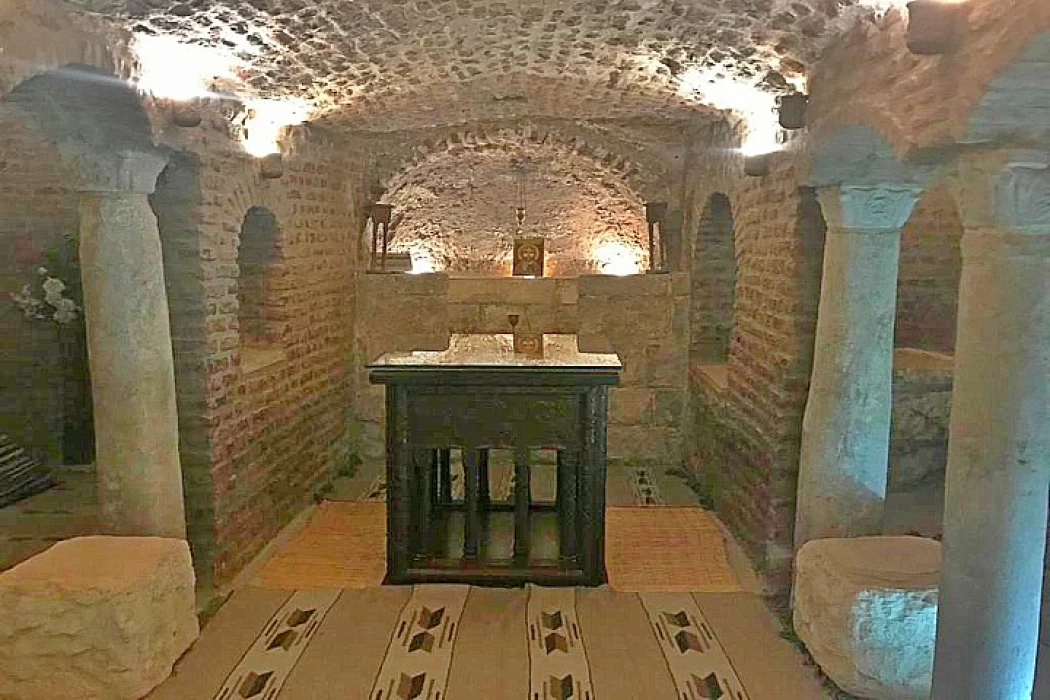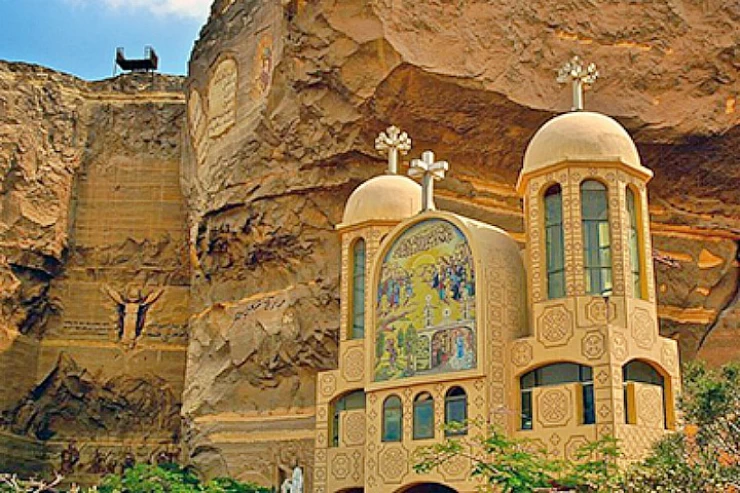
The Church of Saint Sergius and Bacchus
The Church of Saint Sergius and Bacchus (Abu Serga): A Pillar of Coptic Christian Heritage
Introduction
The Church of Saint Sergius and Bacchus, also known as Abu Serga, is a prominent and revered site in Cairo, Egypt. Situated in the heart of the Coptic Christian community, this historic church is a key spiritual and cultural landmark, renowned for its deep religious significance and unique architectural features.
Historical Background
The Church of Saint Sergius and Bacchus, or Abu Serga in Arabic, is named after two Christian martyrs, Saint Sergius and Saint Bacchus, who were soldiers in the Roman army and were martyred for their Christian faith in the 3rd century. They are venerated as saints in both the Coptic Orthodox Church and the Roman Catholic Church.
The church is located in the Old Cairo district, an area rich with historical and religious significance. According to tradition, the church is built on the site where the Holy Family took refuge during their flight into Egypt, as described in the Gospel of Matthew. The location has been a place of Christian worship since the early centuries of Christianity in Egypt.
Architectural Features
The Church of Saint Sergius and Bacchus is noted for its distinctive architectural style, which reflects a blend of ancient Christian and Egyptian influences. The church's structure features a classic basilica layout with a nave, aisles, and a sanctuary. It is characterized by its simplicity, yet it holds significant artistic and historical elements.
One of the most remarkable aspects of the church is its ancient crypt, which is believed to be the resting place of the Holy Family during their time in Egypt. The crypt is a focal point of pilgrimage and spiritual reverence. Visitors can descend into the crypt, where they can see the sacred space believed to have sheltered the Holy Family.
The church also features a number of historical artifacts, including ancient icons and religious texts. The walls are adorned with beautiful Coptic frescoes and intricate woodwork, reflecting the artistic traditions of the early Christian period in Egypt.
Spiritual and Cultural Importance
The Church of Saint Sergius and Bacchus holds a special place in the heart of the Coptic Orthodox community and is a significant pilgrimage site for Christians around the world. Its connection to the Holy Family's journey into Egypt adds a layer of profound spiritual significance, making it a place of deep reverence and devotion.
The church serves as a center for religious worship, with daily services, prayers, and spiritual activities. It is also an important cultural hub, hosting various events and celebrations related to the liturgical calendar of the Coptic Church. The annual feast of Saint Sergius and Bacchus attracts numerous worshippers who come to honor the saints and seek blessings.
In addition to its religious role, the church plays a key role in preserving Coptic Christian heritage. It stands as a symbol of the resilience and continuity of the Coptic community throughout centuries of change and challenge.
Among the manifold historical and cherished structures across Cairo is one of the oldest and most significant statues for Christians, which is the Church of St. Sergius and Bacchus, known as Abu Serga. This old church that is later believed to have existed in the pairs of the fourth century is more than just a worship center for Coptic Christians but a crucial aspect in understanding the religious history of the land of Egypt. Thanks to its association and breathtaking history and architecture, Abu Serga is still a site of worship and pilgrimage for many who come to Egypt from different corners of the globe.
The church of Saint Serga and Bacchus is situated around the Coptic Quarter in Cairo together with other places of Christian importance such as The Hanging Church and The Ben Ezra Synagogue; thus, it is advisable to visit the church for those people who wish to get acquainted with the rarely seen Christian aspect of Egypt.
The church located within the so-called Byzantine walls is dedicated to Saint Sergius and Bacchus, two martyrs who were soldiers in the Roman army under Emperor Maximian himself. It had been fashionable to venerate them in the Eastern Roman Empire during the reign of the growing adversary of Christianity since both suffered from its persecutions. There was even a widespread narrative among early Christians of the suffering of the saints, surrounding such instances of persecution and martyrdom. Thus, this church was built as one of its memorials and is highly associated with the saints’ narrative.
However, the most remarkable one is in connection with the Holy Family: Mary, Joseph, and baby Jesus on their flight to Egypt. It is said in Coptic that the Holy Family sought shelter in a cave under the church during the reign of King Herod. This has turned the church into a popular site of pilgrimage in Egypt, particularly among the Copts who respect the Holy Family for its protective travel.
The Crypt: A Sacred Refuge of the Holy Family
One of the noteworthy and spiritually deepened characteristics of the Church of Saint Sergius and Bacchus is its underground crypt, which is thought to have been the place where the Holy Family stayed while in Egypt. The crypt is situated at a depth of approximately 10 meters and is the focus of many church devotees.
The Very Revered One’s Cafe is a great break from the rather shaky feeling of intimidation. As one enters the low, narrow, dark passageway, the history around them seems to be overwhelming. The crypt is rather small, with just an altar at the spot where the Holy Family is believed to have spent some time. Many visitors bow down in this place, which is so called the Thanksgiving for the Holy Family, praying for the needs of the people who have come for their aid.
The crypt moreover serves to elevate the mystery and the sacredness of the church, as well as floods during the seasons of high Nile waters. For Christians traveling to Egypt, the moment one stands where the Child Jesus was most likely kept is an experience that is impossible to forget.
While the Church of Saint Sergius and Bacchus is less extravagant than most Christian cathedrals, what it lacks in embellishments is more than compensated by its architectural grace that has stood the test of time. The geometric layout of the church is designed in a classic basilica configuration, whereby there is a single central nave, two lateral aisles, and 12 towering pillars that are representative of the 12 apostles. And the wooden ceiling, crafted in the form of the Ark of Noah, resonates with the self-interpretation of the church as a haven.
The church’s interior design and decoration are characterized by the presence of the most beautiful element, which is the iconostasis, or the wooden wall separating the altar from the church. The icons on this screen, which show various biblical scenes and Coptic saints, are striking to the point of making one forget everything and engage in silence. In the center of the temple, just above the altar, there is a large icon of Christ Pantocrator, also known as Christ the All-Powerful, who is directing his gaze on the people in the church.
The interiors of the church are decorated with both ancient frescoes and iconographic paintings, most of them painstakingly preserved for ages. These religious artworks can be likened to masterpieces in aesthetics but are in fact canvas for picturing the Christian religion to include their beliefs and devotion, which extends the sanctity of the space.
As a result of this consideration, the design philosophy of the church contains unusual decor owing to the church’s design stressing more on the spirituality achieved than the decorative aspects. This enhances the tranquil and contemplative atmosphere of the church and is most desirable for individuals wishing to engage in silent prayer or reflection.
The Church of Saint Sergius and Bacchus is of great importance, not only to Coptic Christians but to the entire body of Christ. It ranks as one of the most important locations on the Holy Family Trail, a pilgrimage path that honors the different sites within Egypt that the Holy Family is said to have visited.
Visitors from all over Egypt and the world come to Abu Serga church to pay their respects to the Holy Family, pray in the shrine, and take part in religious services. This church is most crowded during the Feast of the Holy Family, which is celebrated every June 1st, as many people come to the church to remember how the Holy Family fled to Egypt.
In addition, the temple functions as a working church for the Coptic community residing in Cairo. It is here that regular services, masses, and other religious festivities are conducted, in which the congregants come together to express their beliefs and stay in touch with the early Christian saints and Christ’s family.
The Church’s Role in Coptic Cairo
One of the focal points of Coptic Cairo is the Church of Saint Sergius and Bacchus, which is located in a neighborhood that boasts some of the most significant Christian and Jewish sites in Egypt. Coptic culture is an important aspect of Egypt, which had its rich history long before the advent of Islam, and it is fully appreciated the impact of that religion in Egypt today.
Abu Serga is located next to some of the other famous sites of Coptic Cairo, including The Hanging Church, famous for its beautiful nave ‘hanging’ in the air, and the Coptic Museum, which contains a treasure trove of Christian relics, manuscripts, and artworks. The visitors to the church also visit these sites, which helps in understanding the Coptic Orthodox religion and its history in Egypt better.
The church likewise represents the harmonious existence of religions within Egypt because the Ben Ezra Synagogue, one of the oldest synagogues in Egypt, is located next to it. This only gives credence to the claim that for a long time, Egyptians were very tolerant of other religions.















